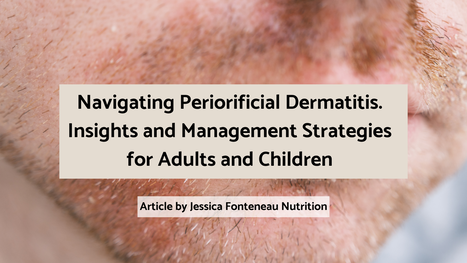ARTICLE Categories
All
|
Navigating Periorificial Dermatitis. Insights and Management Strategies for Adults and Children3/14/2024 Periorificial dermatitis is a broad term encompassing various skin conditions that affect the face, including perioral dermatitis. (1,2).
Today’s article aims to shed light on periorificial dermatitis, its types, symptoms, and triggers, with dedicated insights for both adults and children. Treatment and care as well as the impact of nutrition on its management will also be explored. What is periorificial dermatitis? Periorificial dermatitis is a common, yet often misunderstood skin condition, presenting as rash around the orifices or openings of the face and on the forehead. The different types are:
What are the common symptoms? This condition can be both physically uncomfortable and emotionally distressing. Common symptoms in adults include:
In children periorificial dermatitis is more challenging to diagnose due to overlapping symptoms with other paediatric skin conditions including atopic, contact eczema or even impetigo. Common triggers Common triggers include, but are not exclusive to:
Treatment and Care Medical diagnosis typically involves a clinical examination with a GP or dermatologist. The primary approach to care involves identifying and eliminating triggering factors, such as specific skincare ingredients, environmental irritants or even foods. For adults, medical treatment often includes topical immunomodulators, antibiotics or mild corticosteroids, however studies have shown that with this form of dermatitis the best course of action is often to leave well alone and not apply any creams at all. Recommendations focus on restoring the skin barrier along with a gentle, hypoallergenic skin care regime, alongside stress management and dietary changes. Paediatric management focuses on gentle cleansing and application of hypoallergenic moisturisers to maintain skin hydration. Avoiding known irritants, allergens and intolerances is key, especially if the child has an atopic terrain. I recently worked with an infant whose perioral dermatitis resolved up to 90% with the elimination of one trigger food. The role of nutrition in managing periorificial dermatitis There is no specific diet that focuses on modulating periorificial dermatitis, but nutrition can play a pivotal role in skin health, providing the correct nutrients to modulate inflammation, support natural immune function and strengthen both the gut and skin microbiomes.
Periorificial dermatitis can be challenging but can also be managed with the right approach encompassing medical solutions with lifestyle and nutrition modifications. Understanding the different types of periorificial dermatitis and recognising the importance of nutrition as the foundation to skin health are key steps towards achieving clearer, healthier skin. If you haven’t yet been diagnosed it’s essential to consult with your GP or dermatologist for an accurate diagnosis. Remember, nutrition is just one piece of the puzzle, even if it is a vital one. Skin/Gut Masterclass – Tuesday 19th March 2024 at 12pm UK time. If you are interested in hearing more about the skin/gut connection I am holding a Masterclass this coming Tuesday, 19th March at 12pm UK time. If you register and are unable to attend, you will receive a recording of the event on Wednesday 20th March. You can register here. References
0 Comments
Leave a Reply. |
AuthorI’m Jessica Fonteneau, I’m the eczema specialist and I help people Escape from the Eczema trap. Archives
April 2024
Catégories
All
|


 RSS Feed
RSS Feed